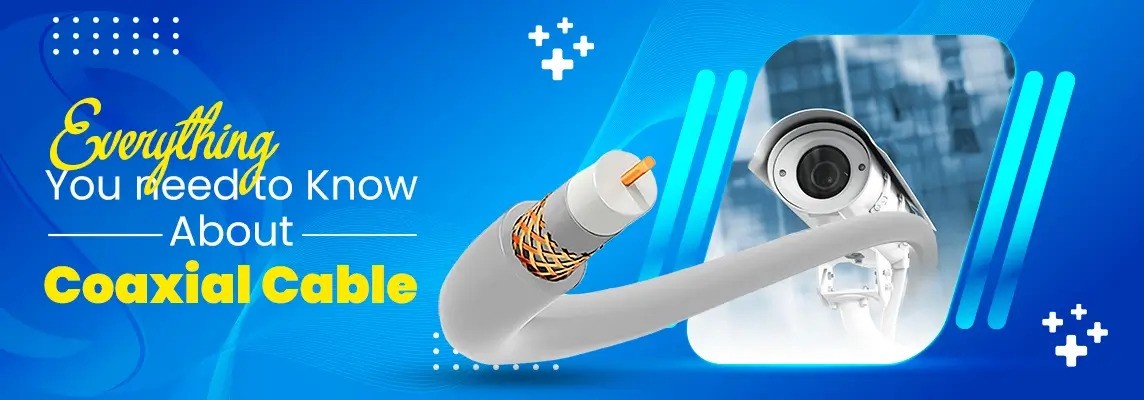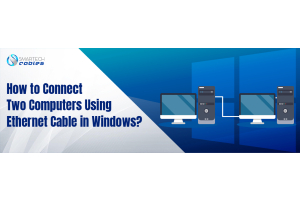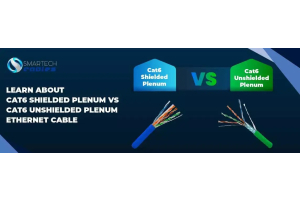Everything You Need To Know About Coaxial Cable

If you are a modern-day consumer, you are surely familiar with different types of networks and networking devices. Coaxial cables, also called Coax cables, are one of the many networking hardware that most people use daily.
Despite the common use of these cables, most modern-day consumers are unfamiliar with what they are and how they work? In this article, we will discuss everything about coax cables from their types to the connectors that are used to connect them.
In the end, you will learn about how you can buy the best cables for your requirements. So, let’s dive into it.
What is a coaxial cable?
A coaxial cable is a networking wire with a single copper conductor. It is used for transmitting data via radio signals in a network. Introduced in the early 1900s, coax cables are still some of the most popular networking cables.
They are used for a variety of applications such as audio/video signal transmission to TVs, satellite antennas, etc. Additionally, there are various types of coax cables and that’s why their uses vary. Types of coaxial cables are discussed in detail in the next part.
Types of coaxial cable:
Coaxial cables differ on two factors: the size of the conductor, which is called gauge, and impedance. Impedance is basically a more specific term for electric resistance.
Based on these two factors, there are four main types of coax cables.
RF
RF coaxial cables are used for transmitting radio frequency signals. They are the most basic version of these cables but used widely with TVs.
RG-6
RF-6 cables have a larger size of the conductor - 6 AWG, precisely, and therefore, support bandwidth capacities in gigahertz. But the best feature of this cable is its overall thin size and it can easily be installed anywhere.
RG-59
The conductor size (AWG) od RG 59 cables is extremely small. They are ideal for applications in household networks due to their lower frequency handling characteristics.
RG-11
If you need to run your coax cable at long lengths, RG 11 is the ideal choice. It has a thick conductor which makes it suitable for high-frequency data transmissions.
Additionally, the thick conductor of this cable and its exceptional shielding make it highly resistive against crosstalk, EMI, and other interferences. It also has a lower attenuation and is best for commercial use.
Coaxial cable connectors:
There is a wide variety of connectors for coax cables and you can take the liberty of choosing the connector of your choice. If you want a highly shielded connector, there’s one and if you need a connector with moderate shielding, there's also an option.
Following are the common and the best Coax cable connectors:
- Bayonet-Concealment Connectors (BNC)
- Micro Coaxial Connectors (MCx)
- Subminiature Version A Connectors (SMA)
- 7/16 Deutsches Institut fur Normung Connectors (7/16 DIN)
- Threaded Neill-Concealman Connectors (TNC)
- Subminiature Version B Connectors (SMB)
- Quick Mate Connectors (QMA)
How does a coaxial cable work?
Coaxial cables are a great choice for data transmission because they are shielded tightly against electromagnetic interference and crosstalk.
The core of a coax cable features a conductor made out of bare copper. It is wrapped carefully in a plastic sheath that insulates it from crosstalk.
Then another plastic is wrapped around it for extra insulation. This is a thicker sheath than the innermost one. After that, a wire mesh surrounds it to drive EMI away from the conductor.
After at least two insulations and one braided aluminum wire mesh, a jacket is wrapped around it to protect everything within it.
Using the state-of-the art shielding, Coaxial cables are able to transmit data at pretty high-speeds.
Uses of a coaxial cable
As mentioned earlier, coaxial cables are used in transmitting data over radio signals.
Here’s the list of the various uses of coaxial cables:
- Sending and receiving signals on satellite antennas
- Transmitting signals for Cable Televisions
- Transmitting internet data signals
- Transmitting high-definition TV signals
- Transmitting signals to other audio/video streaming devices
How to buy coax cables?
The best way to buy coaxial cables is to determine your requirements. Only then you can proceed further. Firstly, figure out which applications you will be using on the cables and at what length you will run them.
Then choose the most appropriate cable for your needs. Of course, you will have to consider your budget, but you need not to worry as these cables are some of the most affordable networking cables out there.
Conclusion:
Coax or Coaxial cables are the most common networking cables and almost every one who is familiar with networking is also familiar with these cables. We hope this guide has provided you with everything you need to know about coax cables.






